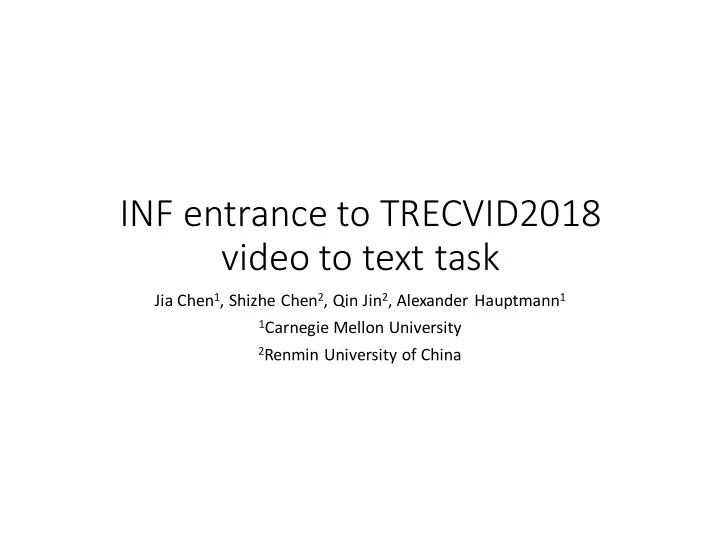

INF entrance to TRECVID2018 video to text task Jia Chen 1 , Shizhe Chen 2 , Qin Jin 2 , Alexander Hauptmann 1 1 Carnegie Mellon University 2 Renmin University of China
Content • Recap and what's new • Network architecture • Limitation of cross-entrpy loss • Bridging the exposure bias • Two losses • Experiments
Recap and What's New • Last year • Dataset vs. Network Architecture • dataset: low hanging fruit • network architecture: not too much improvement* (performance plateu) • What's new in this year • Change the loss used in the caption task • brings large gain *Knowing yourself: Improving video caption via in-depth recap. ACM MM 2017
Network Architecture • Vanilla encoder-decoder architecture[2] [2] Show and tell: A neural image caption generator. O Vinyal etc al. CVPR 2015
Network Architecture (cont'd) • temporal attention[2] [2] Describing videos by exploiting temporal structure. Yao Li etc al. ICCV 2015
Limitation of cross-entrpy loss train stage: test stage: [3] Sequence level training with recurrent neural networks. Ranzato, Marc'Aurelio, et al. ICLR 2015
Bridging the exposure gap • Solution • feed step t-1's output to step t's input through sampling • use evaluation metric as reward* • use REINFORCE to train model (an algorithm of policy gradient in reinforcement learning) 7
Bridging the exposure gap • Caveat • sometimes the algorithm may exploit the loopholes in the reward • Design a robust reward • CIDEr (closer to human evluation compared to BLEU and METEOR) • BCMR • weighted average of BLEU, CIDEr, METEOR, ROUGE
Two losses • self-critique loss • greedy decoding as baseline to reduce variance [4] Self-critical sequence training for image captioning. SJ Rennie, et al. CVPR 2017
Two losses • PROS (partially observable set) loss* distance of two captions s_i and s_j • *work under progress
Experiments • Training set • TGIF (all) • TRECVID16 (optional) • Validation set • TRECVID17 • Feature • Resnet200 (pretrained on ImageNet) • I3D (pretrained on Kinetics-400)
Experiments • performance on validation set model loss BLEU4 METEOR CIDEr vanilla cross entropy 7.1 12.4 27.6 self critique 7.7 13.2 31.3 PROS 8.1 13.9 32.5 temporal attention cross entropy 7.6 12.5 28.9 self critique 7.4 13.0 32.1
Experiments • performance on TRECVID18 model loss BLEU4 METEOR CIDEr vanilla PROS 2.4 23.1 41.6 attention self critique 1.8 22.1 40.8
Conclusion • Reformulate the problem (e.g. by loss) from scratch brings improvement over the current performance plateu
Recommend
More recommend